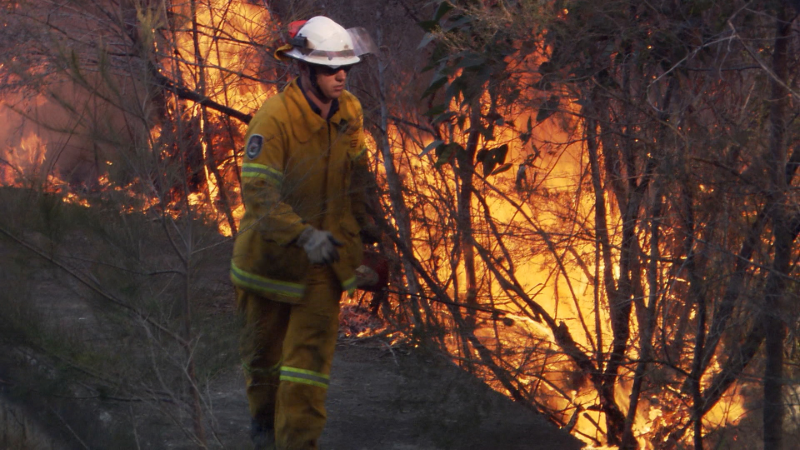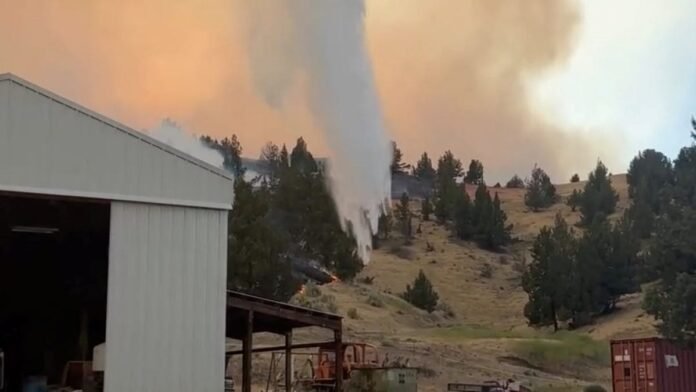
Why are prescribed fires so important to prevent wildfires?
Adam Mendonca, deputy fire director with the U.S. Forest Service, explains why prescribed fires, also known as controlled burns, are critical to prevent wildfires.
The Cram Fire in central Oregon became the nation’s largest wildfire this year as the blaze neared 100,000 acres on July 20, destroying four homes and threatening hundreds of structures, authorities said.
The fire, which broke out on July 13, exploded in size over recent days after hot and dry conditions and gusty winds increased wildfire risks in parts of the state. Fire crews were challenged during the week by changing wind directions and rugged, steep terrain, but cooler temperatures and higher humidity levels over the weekend are expected to help firefighting efforts.
By 9 a.m. local time on July 20, the fire had expanded to 95,748 acres and was 49% contained, according to the Central Oregon Fire Information. The size of the fire was “slightly reduced” from July 19 after “more accurate mapping” was completed, officials said on the fire’s information page.
“Crews are building on the progress made yesterday and overnight,” according to a July 20 update on the fire’s information page. “Cooler temperatures and higher humidity are creating better conditions for mop-up work, especially along the fire perimeter and around structures.”
The fire ignited near Willowdale, a sparsely populated area about 133 miles southeast of Portland, and swept through grasslands and rangeland in the region, fire officials said. The cause of the blaze remains under investigation.
Local authorities in Jefferson, Wasco, and Crook counties have issued evacuation orders or warnings across multiple zones. A total of four residences and two other structures were destroyed in the fire, according to the Jefferson County Sheriff’s Office.
The Cram Fire is one of at least 46 active wildfires, most of which have been contained, in Oregon, according to the state’s fires and hotspots dashboard. The fire also leads the list of wildfire incidents in 2025, followed by the Madre Fire in central California that has burned nearly 81,000 acres, according to InciWeb, a federal government wildfire tracker.
Cram Fire nears megafire status as officials warn of worsening wildfire conditions
The Cram Fire has grown increasingly close to becoming Oregon’s first megafire of the season. A megafire is defined by the National Interagency Fire Center as a wildfire that burns more than 100,000 acres of land.
Fire officials said more than 900 personnel were responding to the blaze in addition to 88 fire engines, 18 handcrews, and eight helicopters. The Central Oregon Fire Information noted on July 20 that while fire behavior has moderated, crews continued to focus on gridding near the fire’s perimeter and reducing materials that have the potential of fueling spot fires.
“Yesterday was another favorable day with us with the weather, and so a lot of good work was done,” Scott Stutzman, operations section chief of the Oregon State Fire Marshal, said in a video update on July 20. “We’ll have those crews out there continuing to maintain a presence mopping up, and also assisting our wildland partners on the perimeter.”
On July 16, Oregon Gov. Tina Kotek declared a state of emergency that will last through the end of the year “due to the imminent threat of wildfire.”
Multiple large wildfires have already exploded in 2025, largely east of the Cascade Range, according to the Salem Statesman Journal, part of the USA TODAY Network. Oregon’s wildfire danger is forecast to remain above normal through summer, the Salem Statesman Journal reported.
“Oregon is already experiencing a devastating wildfire season that will have lasting consequences,” Kotek said in a news release. “The summer is only getting hotter, drier, and more dangerous – we have to be prepared for worsening conditions.”
‘Fire activity is high across the country’
The National Interagency Fire Center warned on July 20 that “fire activity is high across the country,” adding that there are 91 large, uncontained wildfires.
“Nearly 18,000 wildland firefighters and support personnel are on the ground nationwide,” the center said in an update. “In 2025 thus far, there have been 40,934 total wildfires, for a combined acreage of 2,850,245.”
Hot, dry, and windy weather continues to fuel wildfire conditions across parts of the Northwest, Great Basin, and Southwest, according to the center. The center added that some areas were forecast to see wind gusts over 40 mph and low humidity levels “dropping into the single digits.”
The center noted that each year, thousands of wildfires in the United States are caused by people.
“Major causes of these fires include loss of control of debris burning, unattended or unextinguished campfires, and sparks or heat transfer from vehicles and equipment like chainsaws or recreational vehicles,” the center said.
Contributing: Zach Urness and Rose Shimberg, Salem Statesman Journal
